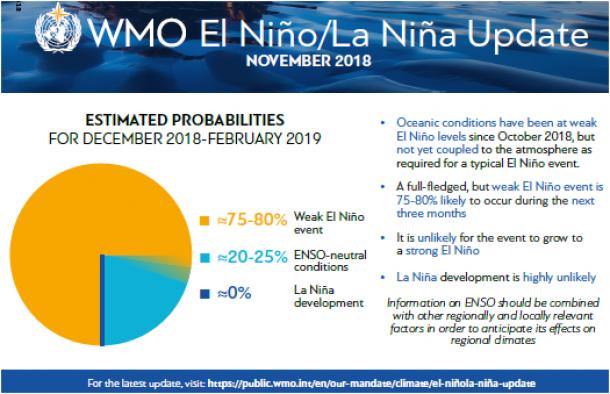The European Space Agency (ESA) posted the video above on December 7, 2018, in response to an El Niño / La Niña update on November 27 from the World Meteorological Organization (WMO). The WMO said in late November there is a “75–80 percent chance” that a fully-fledged El Niño event will be with us by February 2019; however, it is not expected to be a strong event. WMO reported:
Sea surface temperatures are already at weak El Niño levels in part of the tropical Pacific, although the corresponding atmospheric patterns have not yet materialized.
ESA took the opportunity to post the explanatory video above, which describes El Niño and its cooler cousin, La Niña, as opposite phases of what is known as the El Niño-Southern Oscillation. They are complex, naturally occurring climatic phenomena, occurring at irregular intervals of between two and seven years. ESA explained:
As the animation above shows, the first signs of an El Niño are a weakening of the trade winds and warmer-than-usual sea-surface temperatures in the eastern tropical Pacific Ocean. This not only affects fisheries off the coast of South America, but leads to a disruption in weather patterns around the world.
These changing weather patterns can cause heatwaves, drought, wildfires and flooding in different places.
But, again, the coming El Niño is expected to be on the weak side, unlike the 1997–98 El Niño event, which was regarded as one of the strongest El Niño events in recorded history, resulting in widespread drought, flooding and other natural disasters occurring across the globe. The 2014-16 El Niño event was also a very strong one. As for the coming event, the WMO said:
Sea surface temperatures in the east-central tropical Pacific have been at weak El Niño levels since October 2018. However, the atmosphere has not yet responded to this additional warmth, and the upper level winds, cloud and sea level pressure patterns do not yet reflect typical El Niño features.
Model forecasts suggest that this will change within the coming month or two. The chance of a full-fledged El Niño between December 2018 – February 2019 is estimated to be about 75-80 percent, and about 60 percent for it to continue through February-April 2019. Model predictions of the strength of the El Niño range from just a warm-neutral condition through to a moderate strength El Niño event, with sea surface temperatures peaking at approximately 0.8 to 1.2 degrees Celsius above average.
The chance for a strong event (sea surface temperatures in the east-central tropical Pacific rising to at least 1.5 degrees Celsius above average) is currently low.
Maxx Dilley, director of WMO’s Climate Prediction and Adaptation branch, added:
The forecast El Niño is not expected to be as powerful as the event in 2015-2016, which was linked with droughts, flooding and coral bleaching in different parts of the world.
Even so, it can still significantly affect rainfall and temperature patterns in many regions, with important consequences to agricultural and food security sectors, and for management of water resources and public health, and it may combine with long-term climate change to boost 2019 global temperatures.

Bottom line: The World Meteorological Organization said in late November there is a “75–80% chance” that a fully-fledged El Niño event will be with us by February 2019; however, it is not expected to be a strong event. The European Space Agency responded with an excellent video describing El Niño events and their effects.
The 2019 lunar calendars are here! Order yours before they’re gone. Makes a great gift.
Want to see 2018’s brightest comet? How to see comet 46P/Wirtanen











